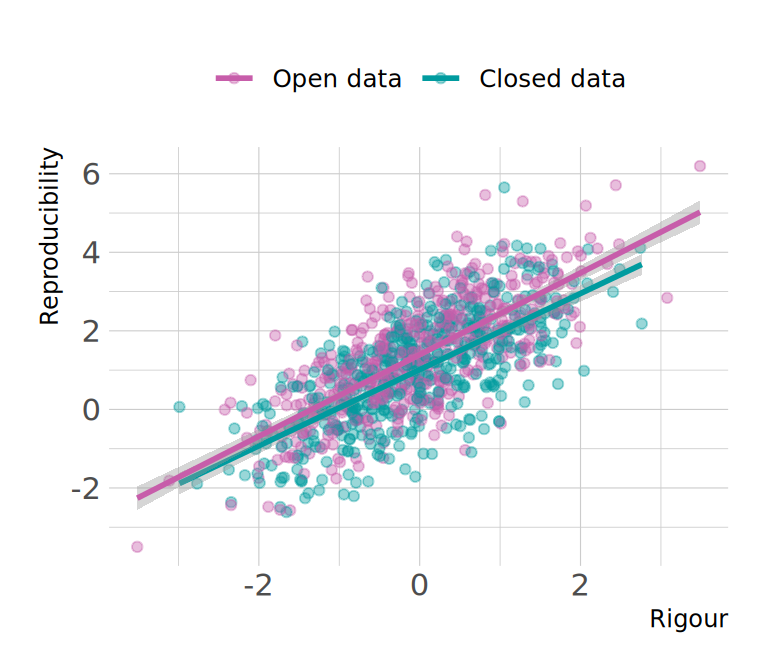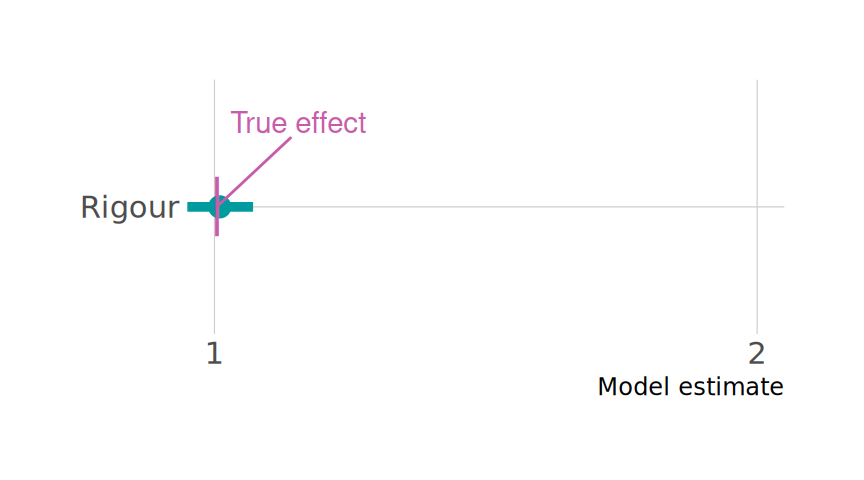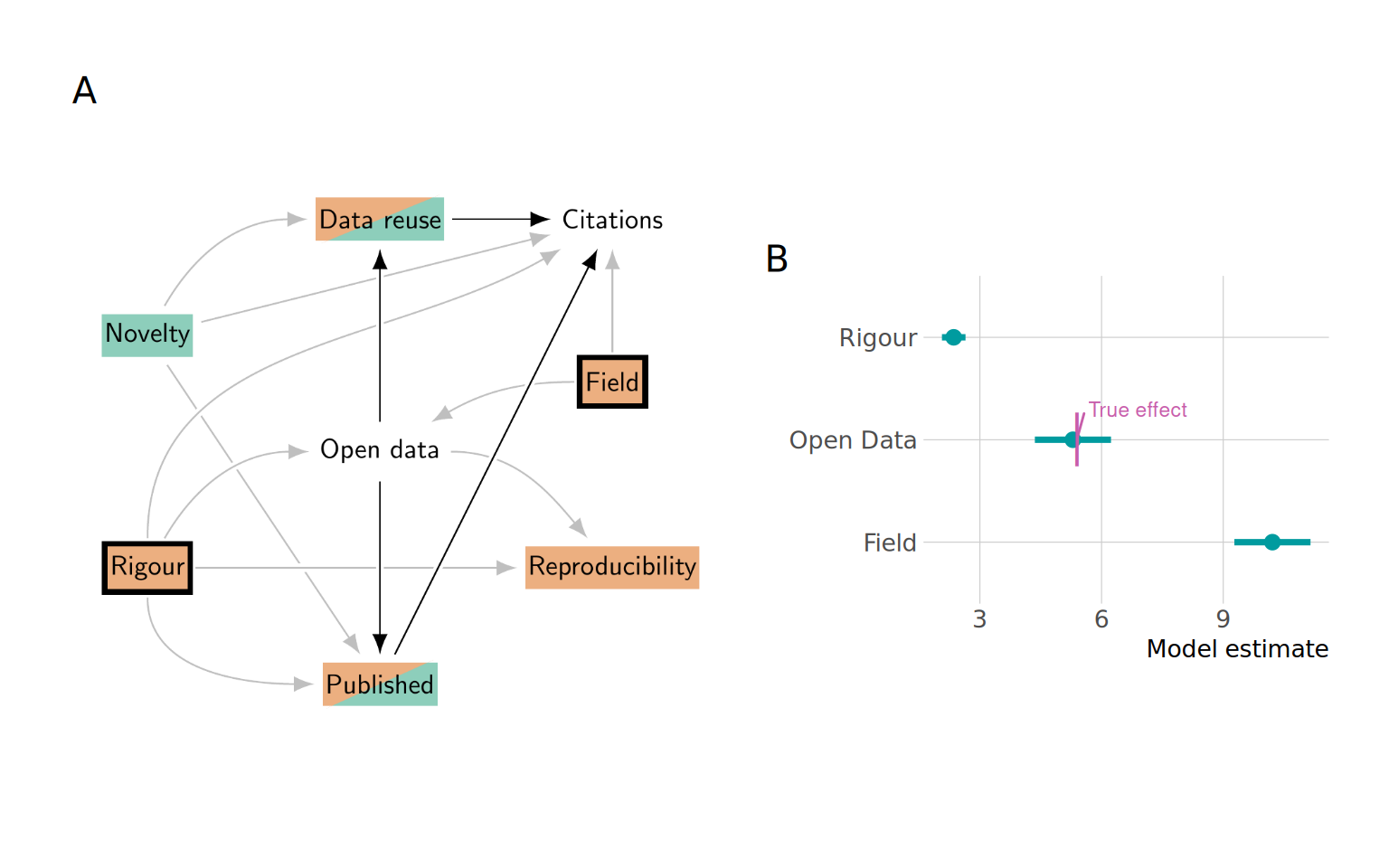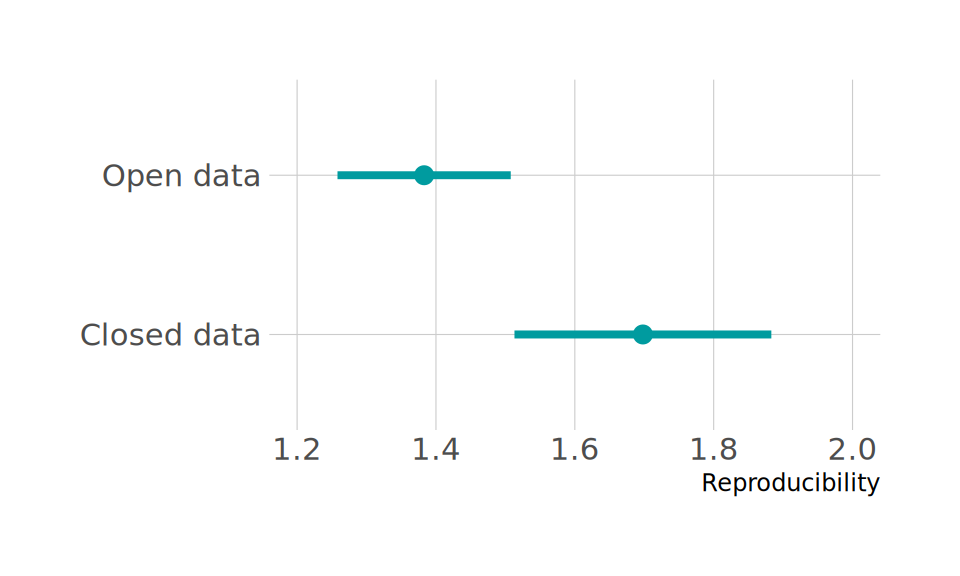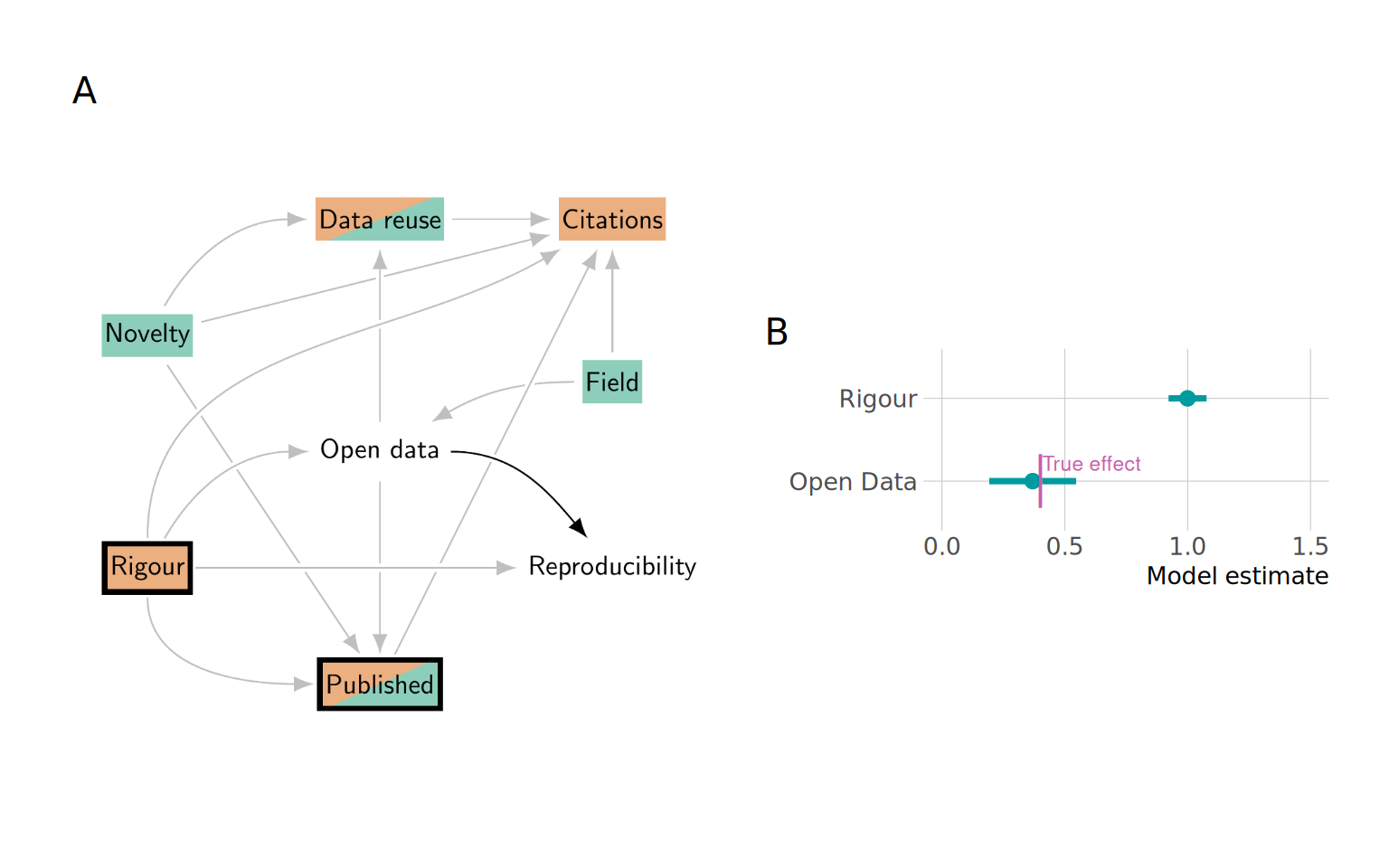Aagaard, Kaare, and Jesper W Schneider. 2017.
“Some Considerations about Causes and Effects in Studies of Performance-Based Research Funding Systems.” J. Informetr. 11 (3): 923–26.
https://doi.org/10.1016/j.joi.2017.05.018.
Altman, Douglas G. 2002.
“Poor-quality medical research: what can journals do?” JAMA 287 (21): 2765–67.
https://doi.org/10.1001/jama.287.21.2765.
Arif, Suchinta, and M. Aaron MacNeil. 2023.
“Applying the Structural Causal Model Framework for Observational Causal Inference in Ecology.” Ecological Monographs 93 (1): e1554.
https://doi.org/10.1002/ecm.1554.
Azoulay, Pierre, Joshua S Graff Zivin, Danielle Li, and Bhaven N Sampat. 2019.
“Public R&D Investments and Private-Sector Patenting: Evidence from NIH Funding Rules.” The Review of Economic Studies 86 (1): 117–52.
https://doi.org/10.1093/restud/rdy034.
Balke, Alexander, and Judea Pearl. 2012.
“Bounds on Treatment Effects from Studies with Imperfect Compliance.” Journal of the American Statistical Association, February.
https://www.tandfonline.com/doi/abs/10.1080/01621459.1997.10474074.
Berrie, Laurie, Kellyn F Arnold, Georgia D Tomova, Mark S Gilthorpe, and Peter W G Tennant. 2025.
“Depicting Deterministic Variables Within Directed Acyclic Graphs: An Aid for Identifying and Interpreting Causal Effects Involving Derived Variables and Compositional Data.” American Journal of Epidemiology 194 (2): 469–79.
https://doi.org/10.1093/aje/kwae153.
Bol, Thijs, Mathijs de Vaan, and Arnout van de Rijt. 2018.
“The Matthew Effect in Science Funding.” Proceedings of the National Academy of Sciences 115 (19): 48874890.
https://doi.org/10.1073/pnas.1719557115.
Bornmann, Lutz. 2011.
“Scientific Peer Review.” Annual Review of Information Science and Technology 45 (1): 197–245.
https://doi.org/10.1002/aris.2011.1440450112.
Bornmann, Lutz, and Hans-Dieter Daniel. 2005.
“Selection of Research Fellowship Recipients by Committee Peer Review. Reliability, Fairness and Predictive Validity of Board of Trustees’ Decisions.” Scientometrics 63 (2): 297–320.
https://doi.org/10.1007/s11192-005-0214-2.
Cinelli, Carlos, Daniel Kumor, Bryant Chen, Judea Pearl, and Elias Bareinboim. 2019.
“Sensitivity Analysis of Linear Structural Causal Models.” In
Proceedings of the 36th International Conference on Machine Learning, 1252–61. PMLR.
https://proceedings.mlr.press/v97/cinelli19a.html.
Cunningham, Scott. 2021. Causal Inference. Yale University Press.
Davis, Philip M. 2020.
“Reanalysis of Tweeting Study Yields No Citation Benefit.” The Scholarly Kitchen.
https://scholarlykitchen.sspnet.org/2020/07/13/tweeting-study-yields-no-benefit/.
Davis, Philip M, Bruce V Lewenstein, Daniel H Simon, James G Booth, and Mathew J L Connolly. 2008.
“Open Access Publishing, Article Downloads, and Citations: Randomised Controlled Trial.” BMJ 337 (7665): 343–45.
https://doi.org/10.1136/bmj.a568.
Deffner, Dominik, Julia M. Rohrer, and Richard McElreath. 2022.
“A Causal Framework for Cross-Cultural Generalizability.” Advances in Methods and Practices in Psychological Science 5 (3): 25152459221106366.
https://doi.org/10.1177/25152459221106366.
Dong, Xianlei, Jiahui Xu, Yi Bu, Chenwei Zhang, Ying Ding, Beibei Hu, and Yang Ding. 2022.
“Beyond Correlation: Towards Matching Strategy for Causal Inference in Information Science.” Journal of Information Science 48 (6): 735–48.
https://doi.org/10.1177/0165551520979868.
Elwert, Felix. 2013.
“Graphical Causal Models.” In, edited by Stephen L. Morgan, 245–73. Handbooks of Sociology and Social Research. Dordrecht: Springer Netherlands.
https://doi.org/10.1007/978-94-007-6094-3_13.
Esterling, Kevin M., David Brady, and Eric Schwitzgebel. 2025.
“The Necessity of Construct and External Validity for Deductive Causal Inference.” Journal of Causal Inference 13 (1).
https://doi.org/10.1515/jci-2024-0002.
Fecher, Benedikt, and Sascha Friesike. 2014.
“Open Science: One Term, Five Schools of Thought.” In, edited by Sönke Bartling and Sascha Friesike, 17–47. Cham: Springer International Publishing.
https://doi.org/10.1007/978-3-319-00026-8_2.
Gläser, Jochen, and Grit Laudel. 2016.
“Governing Science: How Science Policy Shapes Research Content.” European Journal of Sociology 57 (1): 117–68.
https://doi.org/10.1017/S0003975616000047.
Goodman, Steven N., Jesse Berlin, Suzanne W. Fletcher, and Robert H. Fletcher. 1994.
“Manuscript Quality Before and After Peer Review and Editing at Annals of Internal Medicine.” Annals of Internal Medicine 121 (1): 11–21.
https://doi.org/10.7326/0003-4819-121-1-199407010-00003.
Hardwicke, Tom E., Manuel Bohn, Kyle MacDonald, Emily Hembacher, Michèle B. Nuijten, Benjamin N. Peloquin, Benjamin E. deMayo, Bria Long, Erica J. Yoon, and Michael C. Frank. 2021.
“Analytic Reproducibility in Articles Receiving Open Data Badges at the Journal Psychological Science: An Observational Study.” Royal Society Open Science 8 (1): 201494.
https://doi.org/10.1098/rsos.201494.
Hardwicke, Tom E., Maya B. Mathur, Kyle MacDonald, Gustav Nilsonne, George C. Banks, Mallory C. Kidwell, Alicia Hofelich Mohr, et al. 2018.
“Data Availability, Reusability, and Analytic Reproducibility: Evaluating the Impact of a Mandatory Open Data Policy at the Journal Cognition.” Royal Society Open Science 5 (8): 180448.
https://doi.org/10.1098/rsos.180448.
Healy, Kieran. 2017.
“Fuck Nuance.” Sociological Theory 35 (2): 118–27.
https://doi.org/10.1177/0735275117709046.
Hünermund, Paul, and Elias Bareinboim. 2023.
“Causal Inference and Data Fusion in Econometrics.” arXiv.
https://doi.org/10.48550/arXiv.1912.09104.
Huntington-Klein, Nick. 2021. The Effect: An Introduction to Research Design and Causality. CRC Press.
Imbens, Guido W., and Donald B. Rubin. 2015.
Causal Inference for Statistics, Social, and Biomedical Sciences: An Introduction. Cambridge: Cambridge University Press.
https://doi.org/10.1017/CBO9781139025751.
Jacob, Brian A., and Lars Lefgren. 2011.
“The Impact of Research Grant Funding on Scientific Productivity.” Journal of Public Economics, Special issue: The role of firms in tax systems, 95 (9): 1168–77.
https://doi.org/10.1016/j.jpubeco.2011.05.005.
Jefferson, Tom, Philip Alderson, Elizabeth Wager, and Frank Davidoff. 2002.
“Effects of Editorial Peer Review: A Systematic Review.” JAMA 287 (21): 2784.
https://doi.org/10.1001/jama.287.21.2784.
Klebel, Thomas, Nicki Lisa Cole, Lena Tsipouri, Eva Kormann, Istvan Karasz, Sofia Liarti, Lennart Stoy, Vincent Traag, Silvia Vignetti, and Tony Ross-Hellauer. 2023.
“PathOS - D1.2 Scoping Review of Open Science Impact,” May.
https://zenodo.org/record/7883699.
Kwon, Seokbeom, and Kazuyuki Motohashi. 2021.
“Incentive or Disincentive for Research Data Disclosure? A Large-Scale Empirical Analysis and Implications for Open Science Policy.” International Journal of Information Management 60 (October): 102371.
https://doi.org/10.1016/j.ijinfomgt.2021.102371.
Liénard, Jean F., Titipat Achakulvisut, Daniel E. Acuna, and Stephen V. David. 2018.
“Intellectual Synthesis in Mentorship Determines Success in Academic Careers.” Nature Communications 9 (1): 4840.
https://doi.org/10.1038/s41467-018-07034-y.
Liu, Lu, Benjamin F. Jones, Brian Uzzi, and Dashun Wang. 2023.
“Data, Measurement and Empirical Methods in the Science of Science.” Nature Human Behaviour 7 (7): 1046–58.
https://doi.org/10.1038/s41562-023-01562-4.
Luc, Jessica G. Y., Michael A. Archer, Rakesh C. Arora, Edward M. Bender, Arie Blitz, David T. Cooke, Tamara Ni Hlci, et al. 2021.
“Does Tweeting Improve Citations? One-Year Results From the TSSMN Prospective Randomized Trial.” The Annals of Thoracic Surgery 111 (1): 296–300.
https://doi.org/10.1016/j.athoracsur.2020.04.065.
Lundberg, Ian, Rebecca Johnson, and Brandon M. Stewart. 2021.
“What Is Your Estimand? Defining the Target Quantity Connects Statistical Evidence to Theory.” American Sociological Review 86 (3): 532–65.
https://doi.org/10.1177/00031224211004187.
Ma, Yifang, Satyam Mukherjee, and Brian Uzzi. 2020.
“Mentorship and Protégé Success in STEM Fields.” Proceedings of the National Academy of Sciences 117 (25): 14077–83.
https://doi.org/10.1073/pnas.1915516117.
Malmgren, R. Dean, Julio M. Ottino, and Luís A. Nunes Amaral. 2010.
“The Role of Mentorship in Protégé Performance.” Nature 465 (7298): 622–26.
https://doi.org/10.1038/nature09040.
McElreath, Richard. 2020. Statistical Rethinking: A Bayesian Course with Examples in r and Stan. 2nd ed. CRC Texts in Statistical Science. Boca Raton: Taylor; Francis, CRC Press.
Molloy, Jennifer C. 2011.
“The Open Knowledge Foundation: Open Data Means Better Science.” PLoS Biology 9 (12): e1001195.
https://doi.org/10.1371/journal.pbio.1001195.
Munafò, Marcus R., and George Davey Smith. 2018.
“Robust Research Needs Many Lines of Evidence.” Nature 553 (7689): 399–401.
https://doi.org/10.1038/d41586-018-01023-3.
Nosek, Brian A., Tom E. Hardwicke, Hannah Moshontz, Aurélien Allard, Katherine S. Corker, Anna Dreber, Fiona Fidler, et al. 2022.
“Replicability, Robustness, and Reproducibility in Psychological Science.” Annual Review of Psychology 73 (1): 719–48.
https://doi.org/10.1146/annurev-psych-020821-114157.
Nuijten, Michèle B., Jeroen Borghuis, Coosje L. S. Veldkamp, Linda Dominguez-Alvarez, Marcel A. L. M. van Assen, and Jelte M. Wicherts. 2017.
“Journal Data Sharing Policies and Statistical Reporting Inconsistencies in Psychology.” Edited by Simine Vazire and Chris Chambers.
Collabra: Psychology 3 (1): 31.
https://doi.org/10.1525/collabra.102.
Pearl, Judea. 2009.
Causality: Models, Reasoning, and Inference. 2nd ed. Cambridge University Press.
https://doi.org/10.1017/CBO9780511803161.
Piwowar, Heather, Roger Day, and Douglas Fridsma. 2007.
“Sharing Detailed Research Data Is Associated with Increased Citation Rate.” Edited by John Ioannidis.
PLoS ONE 2 (3): e308.
https://doi.org/10.1371/journal.pone.0000308.
Piwowar, Heather, and Todd J. Vision. 2013.
“Data Reuse and the Open Data Citation Advantage.” https://doi.org/10.7287/peerj.preprints.1v1.
Rohrer, Julia M. 2018.
“Thinking Clearly about Correlations and Causation: Graphical Causal Models for Observational Data.” Advances in Methods and Practices in Psychological Science 1 (1): 27–42.
https://doi.org/10.1177/2515245917745629.
Rohrer, Julia M., Paul Hünermund, Ruben C. Arslan, and Malte Elson. 2022.
“That’s a Lot to Process! Pitfalls of Popular Path Models.” Advances in Methods and Practices in Psychological Science 5 (2): 25152459221095827.
https://doi.org/10.1177/25152459221095827.
Ross-Hellauer, Tony, Thomas Klebel, Alexandra Bannach-Brown, Serge P. J. M. Horbach, Hajira Jabeen, Natalia Manola, Teodor Metodiev, et al. 2022.
“TIER2: Enhancing Trust, Integrity and Efficiency in Research Through Next-Level Reproducibility.” Research Ideas and Outcomes 8 (December): e98457.
https://doi.org/10.3897/rio.8.e98457.
Rowhani-Farid, Anisa, Michelle Allen, and Adrian G. Barnett. 2017.
“What Incentives Increase Data Sharing in Health and Medical Research? A Systematic Review.” Research Integrity and Peer Review 2 (1): 4.
https://doi.org/10.1186/s41073-017-0028-9.
Schmal, W. Benedikt, Justus Haucap, and Leon Knoke. 2023.
“The Role of Gender and Coauthors in Academic Publication Behavior.” Research Policy 52 (10): 104874.
https://doi.org/10.1016/j.respol.2023.104874.
Simsek, Müge, Mathijs de Vaan, and Arnout van de Rijt. 2024.
“Do Grant Proposal Texts Matter for Funding Decisions? A Field Experiment.” Scientometrics 129 (5): 2521–32.
https://doi.org/10.1007/s11192-024-04968-7.
Smaldino, Paul E. 2023. Modeling Social Behavior: Mathematical and Agent-Based Models of Social Dynamics and Cultural Evolution. Princeton: Princeton University Press.
Smith, Richard. 2006.
“Peer Review: A Flawed Process at the Heart of Science and Journals.” Journal of the Royal Society of Medicine 99 (4): 178–82.
https://doi.org/10.1258/jrsm.99.4.178.
Sugimoto, Cassidy R., Chaoqun Ni, Terrell G. Russell, and Brenna Bychowski. 2011.
“Academic Genealogy as an Indicator of Interdisciplinarity: An Examination of Dissertation Networks in Library and Information Science.” Journal of the American Society for Information Science and Technology 62 (9): 1808–28.
https://doi.org/10.1002/asi.21568.
Tashakkori, Abbas, R. Burke Johnson, and Charles Teddlie. 2021. Foundations of Mixed Methods Research: Integrating Quantitative and Qualitative Approaches in the Social and Behavioral Sciences. Second edition. Los Angeles London New Delhi Singapore Washington DC Melbourne: SAGE.
Tennant, Jonathan P., François Waldner, Damien C. Jacques, Paola Masuzzo, Lauren B. Collister, and Chris H. J. Hartgerink. 2016.
“The Academic, Economic and Societal Impacts of Open Access: An Evidence-Based Review,” September.
https://doi.org/10.12688/f1000research.8460.3.
Textor, Johannes, Benito van der Zander, Mark S Gilthorpe, Maciej Liśkiewicz, and George TH Ellison. 2016.
“Robust Causal Inference Using Directed Acyclic Graphs: The R Package ‘Dagitty’.” International Journal of Epidemiology 45 (6): 1887–94.
https://doi.org/10.1093/ije/dyw341.
Tomkins, Andrew, Min Zhang, and William D Heavlin. 2017.
“Reviewer Bias in Single- Versus Double-Blind Peer Review.” Proc. Natl. Acad. Sci. U. S. A. 114 (48): 12708–13.
https://doi.org/10.1073/pnas.1707323114.
Traag, V. A., and L. Waltman. 2022.
“Causal Foundations of Bias, Disparity and Fairness.” arXiv.
https://doi.org/10.48550/arXiv.2207.13665.
Waltman, Ludo, and Nees Jan van Eck. 2019.
“Field Normalization of Scientometric Indicators.” Springer Handbook of Science and Technology Indicators, 281–300.
https://doi.org/10.1007/978-3-030-02511-3_11.
Westreich, Daniel, and Sander Greenland. 2013.
“The Table 2 Fallacy: Presenting and Interpreting Confounder and Modifier Coefficients.” American Journal of Epidemiology 177 (4): 292–98.
https://doi.org/10.1093/aje/kws412.
Woods, Helen Buckley, and Stephen Pinfield. 2022.
“Incentivising Research Data Sharing: A Scoping Review.” Wellcome Open Research 6 (April): 355.
https://doi.org/10.12688/wellcomeopenres.17286.2.
Yarkoni, Tal. 2019.
“The Generalizability Crisis,” November.
https://doi.org/10.31234/osf.io/jqw35.
